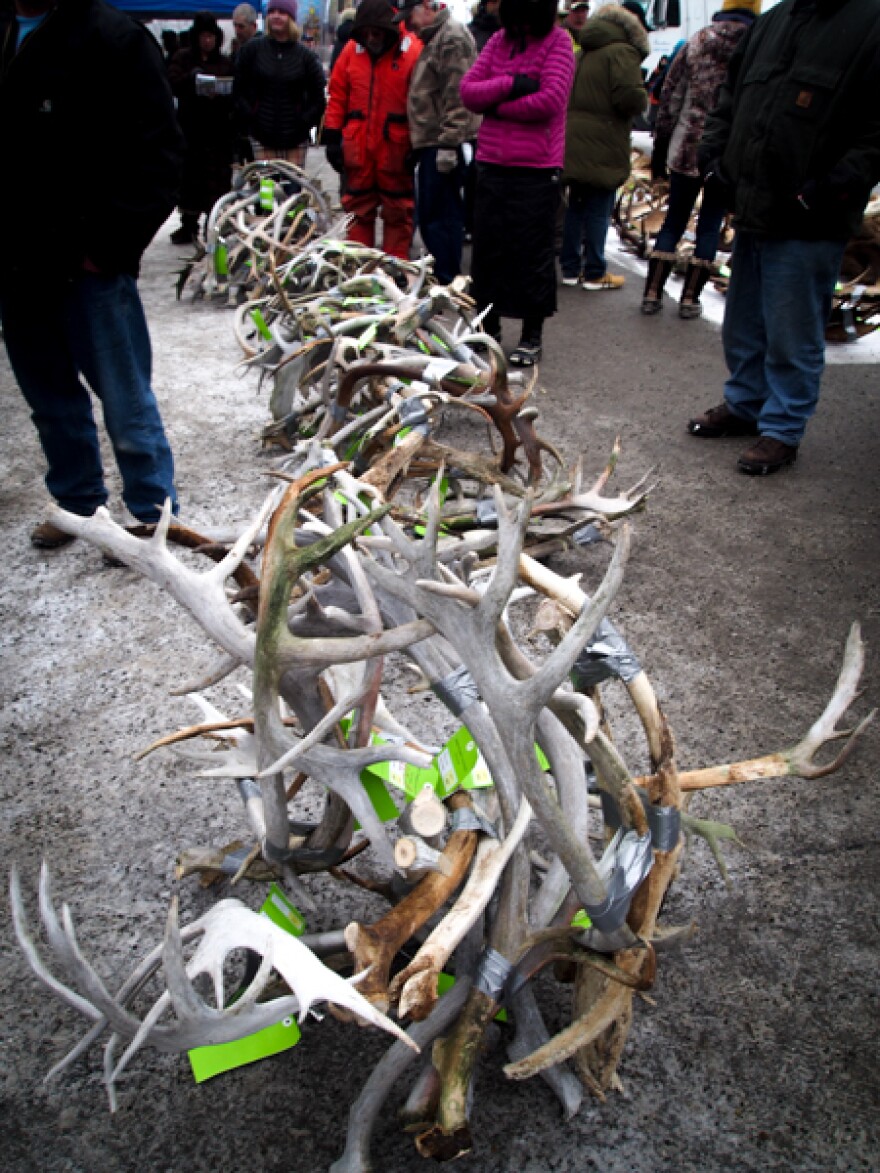The Alaska Department of Fish and Game held its annual "Hide and Horn" auction Sunday, selling off all the leftover animal products the state comes to possess while managing Alaska's wildlife. The auction is not only a Fur Rondy tradition, but part of how the state manages its wildlife resources.
This year, an unprecedented number of caribou antlers went to bid, the result of a trafficking case stretching from Juneau to the Northwest Arctic community of Selawik.
Just past the fairgrounds in downtown Anchorage, crowds of people strolled between dozens of bear hides, sheep capes, and bundles of caribou antlers duck-taped together, resembling thigh-high tumbleweeds. On stage, helpers hoisted spindly, branch-like antlers high overhead while the auctioneer coaxed patrons towards $150 or $175 a set.
"I'm owner of Knight's Taxidermy here in Anchorage, Alaska,” said Russell Knight, “and I'm down here to buy bear hides, horns and antlers, and anything else I can get."
Knight and many of the more aggressively bidders are professional buyers, loading up on supplies for taxidermy, handicrafts, and fine arts at relatively low prices. This is the state's largest auction of wildlife products, and is part of Anchorage's annual Fur Rondy celebration.
Richard Person is the head of the Southcentral Chapter of the Alaska Trappers Association, and explained the origins of Fur Rondy—short for ‘fur rendezvous.’ “Traditionally a rendezvous would be where the hunters and trappers would come together, drink a lot of whiskey, and sell their pelts."
The Trappers Association has won the contract to put on the auction for the state the last few years, and Person believes it is one of the few ways the state is able to share some of its rarest resources with residents.
“It gives a chance for regular folks who don't have an opportunity maybe to take one of these animals in a hunting situation to come and still participate and own a piece of Alaska…that is unique,” Person said.
This year's auction is especially unique. The state had 3,000 pounds of caribou antlers for sale, about five times the usual.
Most are from just one criminal case.
Nome-based Wildlife Trooper Brian Miller was stationed flew to Kotzebue in 2011 to investigate reports of an outside buyer shipping huge quantities of antlers to the road system on a commercial freight plane.
“It had been sent from the village of Selawik,” Miller recalled. “Prior to the shipping from the village it had been wrapped up on pallets. Stacks of antlers wrapped in plastic, probably about four to five feet high."
It is illegal to buy or sell raw antlers that were not naturally shed in the Northwest Arctic Borough, where caribou are a key subsistence stock. That regulation came after pressure from antler merchants in the ‘80s and ‘90s led to a troubling wave of wanton waste cases along the banks of the Kobuk and Noatak rivers.
In the 2011 case, the state brought 22 misdemeanor charges against Harbor Stanton of Copper Center, whose trip, according to charging documents, was financed for $10,5000 by Ivory Jack's Trading company in Juneau.
“I've not come across that before or since,” said Miller of the several pallets recovered both in Kotzebue and Selawik. Many of the antlers had been split into pieces by a band-saw to make them easier to transport.
Stanton settled the case in July of 2014. He was fined $500 dollars and forfeited the antlers.
Which begs the question: what is the state to do when it suddenly acquires 2,000 pounds of illegal caribou antlers?
Since they do not need to be fleshed or sealed like hides, they head straight to a warehouse until they find a new home.
Wildlife Technician Jim Holmes is with the Alaska Department of Fish and Game. It is his job to wrangle the full force of the state's bureaucracy when it comes to sharing wildlife resources--even the ones obtained in unfortunate circumstances.
"Typically, throughout the year I get requests from schools, museums, educational facilities, visitor centers--places like that--who are requesting these items for educational purposes,” Holmes said, sitting in his office near to the many mounts and skulls decorating the ADF&G building in Anchorage.
Holmes estimates the annual auction is just one percent of his total workload. Most of the time he arranges for road-kill, animals taken out of season, or in Defense of Life and Property, to be taxidermied or tanned, then redistributed to public areas where residents can view them.
The auction usually brings between $40,000 and $60,000 in revenue, which covers the costs of handling all the horns and hides the department manages in the course of a year.



